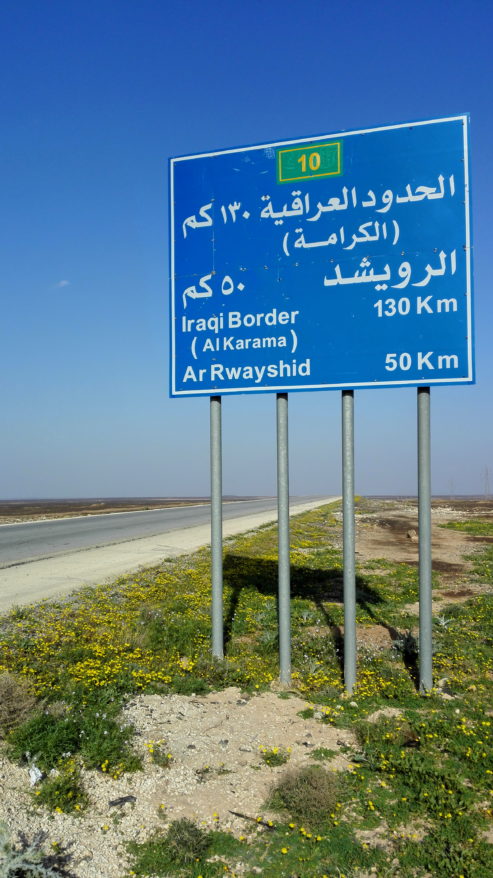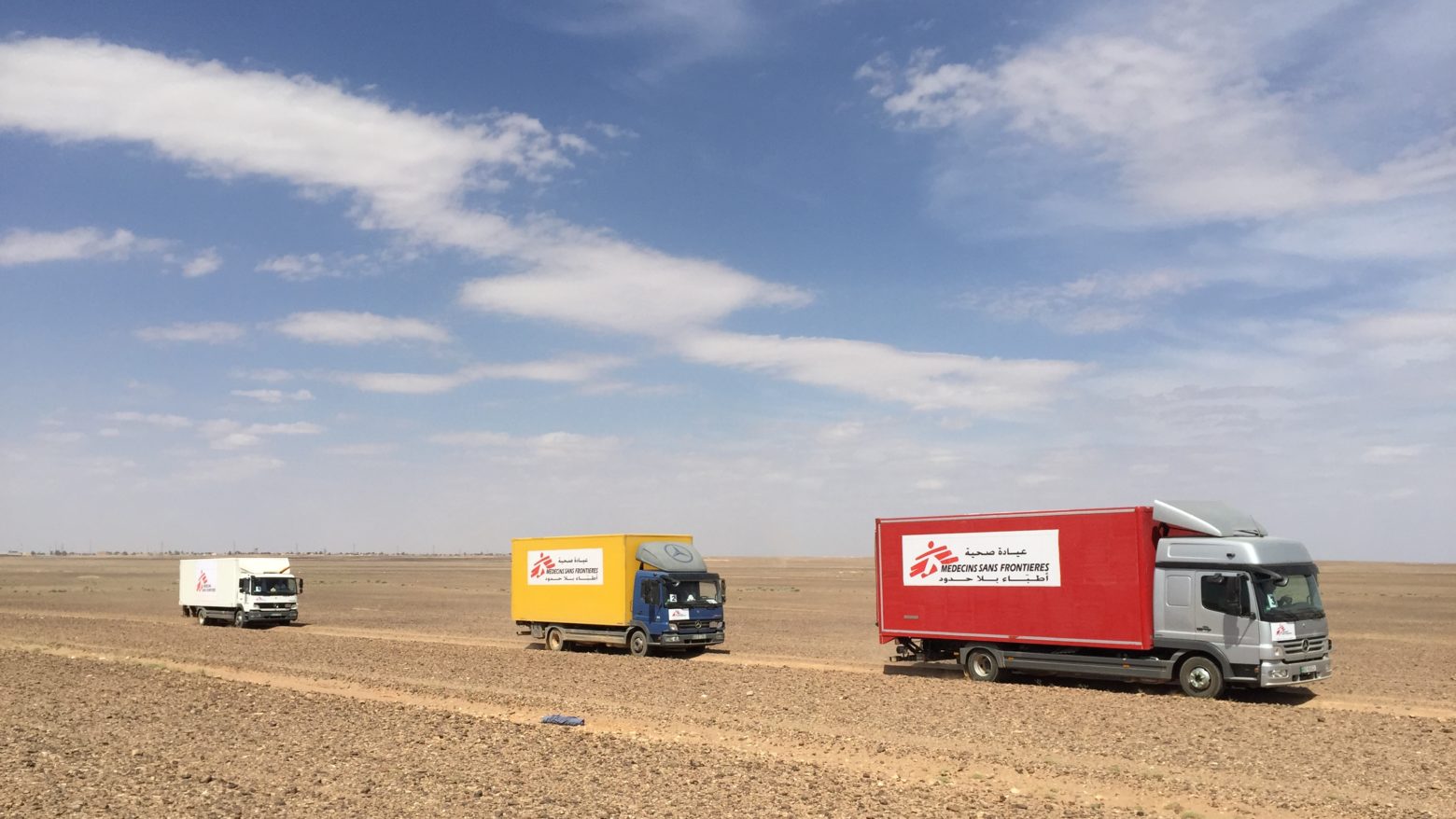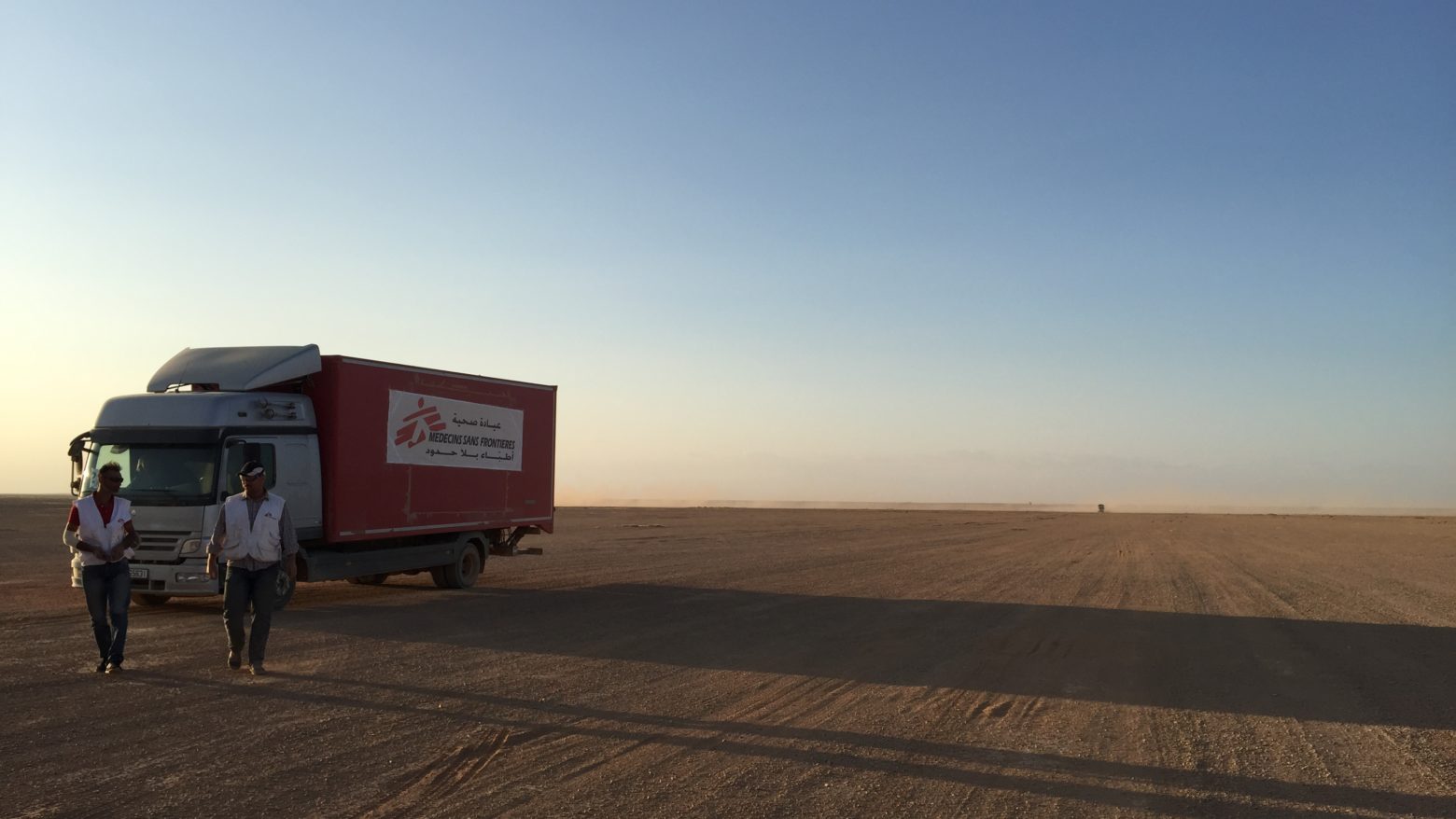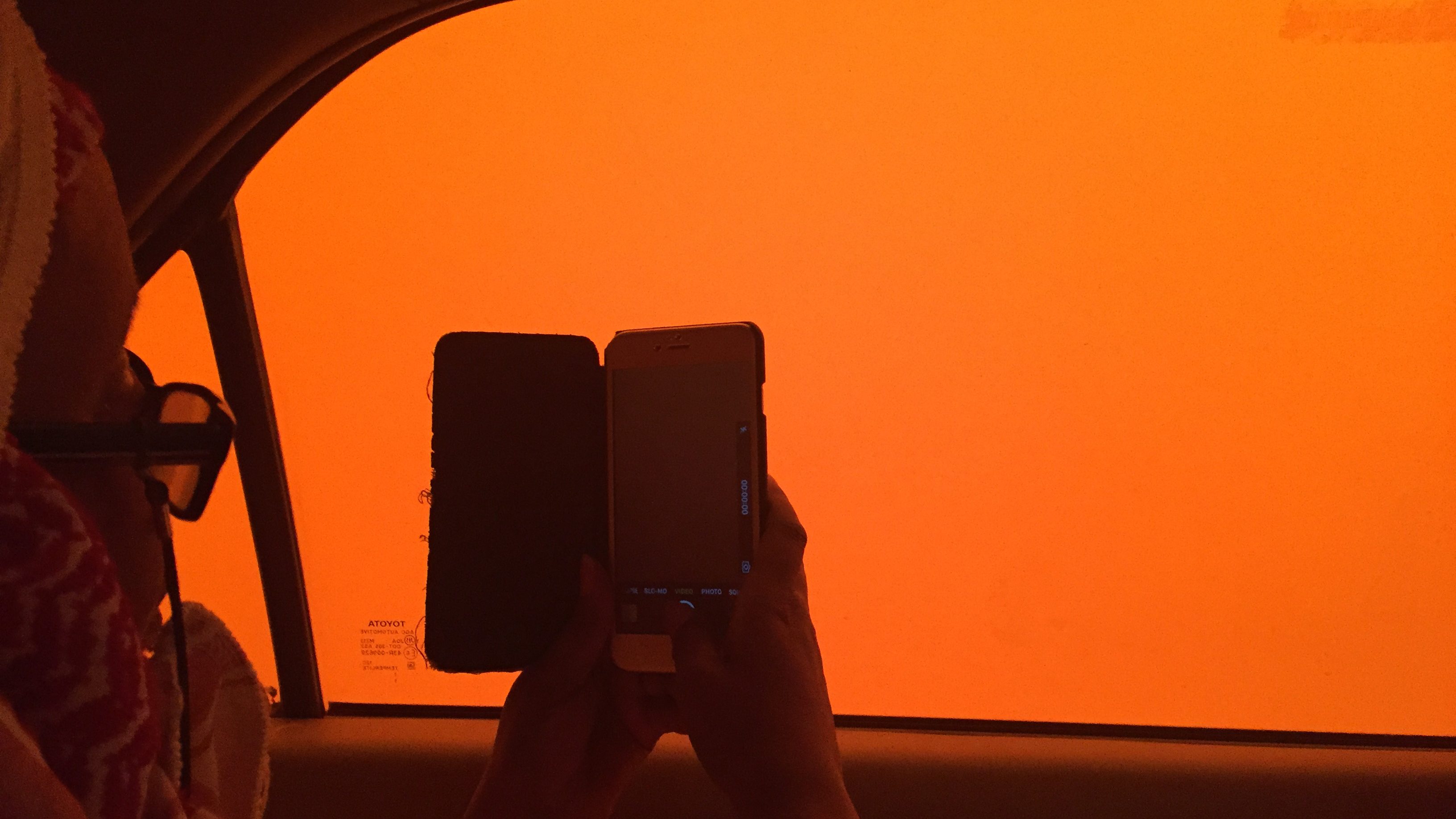We were pulling away from the border when a sandstorm came on, fast and hard. In front of the car was swirling sand; behind, the sky was clotted black. Everything went red, and then dim, as though we were passing through a cave. It only took a few minutes for the wind to pass, but in that time, it raged through a nearby refugee camp, tearing apart flimsy structures and blanketing everything with dirt.
The border between northeastern Jordan and Syria didn’t look like a border. It was an endless stretch of sand. It was an informal camp and city and economy, a pile of fabric tents and plastic canteens, populated with families and smugglers. A man-made dune separated the land that was theoretically Syria from that of Jordan, and separated some 80,000eighty thousand people from life in Jordan and confinement in the desert.
As the Syrian war forced millions of people to flee, the historically porous borders around Syria remained open for the first few years of the conflict. But in 2014 they began snapping shut. Lebanon, Turkey, and Jordan—countries that had accepted hundreds of thousands of Syrian refugees—were now following Europe’s lead and adopting policies of containment. By early January 2016, tens of thousands of Syrians were trapped at the edges of their country. The growing population at Jordan’s northeastern border lived in a demilitarized zone between the two countries.
The closest I got to one of two settlements, called the Rukban berm (for the sand dunes marking Jordanian and Syrian territory), was to stand on this small ridge and look out over it. It was May 2016; I was at the berm as a humanitarian-affairs officer with Médecins Sans Frontières (MSF). We were prohibited from actually entering the camp and had to set up our mobile health clinic on a swatch of land on the other side of the dune. The Jordanian government tightly controlled every hour of access to the berm, citing safety concerns. MSF determined we couldn’t construct a clinic there, because there was no security at night, and the structures other aid agencies put up had gone missing. Instead, we drove in and out every day in trucks that transformed into a women’s clinic, a pediatric room, and a pharmacy. Jordanian doctors and nurses, working with a smaller number of expat medics, saw, on average, two hundred people a day.

We went to the border in a convoy of used Toyota Forerunner SUVs, the clinic trucks trailing behind. We left the nearest town of Ruwayshid, where we had our base, at 6:30 a.m. It took three or four hours to reach the berm, the majority of the drive on unpaved desert tracks. Inside the Toyotas, the sand came in through the seat-belt holsters and the vents. I tied a scarf across my mouth to filter out the dust.
To reach the berm, we had to pass through three army checkpoints. At the latter two, our cars were searched and our passes checked. The Jordanian army officials manning these desert outposts were kids. They looked at us with a mixture of curiosity and contempt. They rifled through the cars and checked IDs and let us use their bathrooms, holes in the ground surrounded by shit and angry flies.
At one of the checkpoints, the SUVs of the UN and other NGOs piled up. One UN agency had hired a company that was half-owned by the Jordanian military to truck in water. The UN was also trying to erect a service center at the berm, but it would never open; it remained a giant maze of empty shipping containers, something out of a strange children’s story.
Our arrival at the berm was an event. Women and children lined up before MSF’s convoy appeared, patiently waiting in the sun. Far more of them clustered at the entrance of the sand pit to wait for the bread and water trucks. When they arrived, Jordanian guards pushed back the refugees with sticks and the tips of their black boots. Some had whips that cracked through the air and fell on anyone who didn’t run fast enough.
After we set up, kids ran over to play with the neon-orange plastic fencing that demarcated the clinic space. They begged for Vaseline to rub on their chapped cheeks, where dry skin formed raised patterns. They asked for food and water. There was no school to occupy their time; instead they played games, fought, helped their parents. The kids and their mothers had fled Russian and Syrian government bombs. Some had escaped from ISIL-controlled territory. They came to the berm from Homs, Palmyra, Aleppo, and Raqqa, usually traveling with smugglers. Dentists, teachers, nurses, tailors, shopkeepers. There were still others who were not refugees, but were locals to the area, some of whom profited from the refugees; we had no real way of estimating how many.
MSF could only operate for four hours a day, since we needed to leave before dark for the journey home. The time sped by, a constant triage of patients. The heat at the border was an interminable sauna, more than 40 degrees Celsius in the summer. People were surviving there on less than ten liters of water per day; although many had been there for months, they could not shower or wash their clothes. I tried to drink water in secret, but there was no shelter except in the shadows of our trucks. There were also no bathrooms at the berm; women who needed to give a urine sample had to pee behind an orange panel. Often, it fell over from the wind.
There was a five-year-old boy at the berm who needed stiches removed from his eye, but we were unable to perform surgeries. His father came to see us several days in a row. I wrote his name on a piece of paper and passed it to a UN agency, certain that this boy would never have this eye operated on, that the stiches would become infected. But I could not bring myself to tell him this. There were children there with epilepsy, babies that could not breastfeed, adults with hypertension, asthma, and diabetes. There were also reports that those arriving to the berm from ISIL territories had been subjected to new forms of trauma; a woman had been put underground in a metal box for twenty-four hours while her husband was tortured above her.
One day a child arrived in a wheelbarrow; she was unable to walk, her limbs shrunken and frail, belly distended. There were several other kids who arrived so malnourished that our medics thought they would die if they did not get to a hospital. I walked with the families to the Jordanian military ambulance to try and get the kids referred into Jordan. The Jordanian army nurse in charge was sympathetic; he also came to evaluate the patients, and said he’d try his best. Some got in and others did not.

At night, back in the small border town of Ruwayshid, water washed away the sand. Ruwayshid was about eighty kilometers from Iraq and fifty from Syria. Here it felt like something out of the American West—an abandoned border post, suddenly coming alive. The nearby border closures with Iraq and Syria had devastated local businesses, but suddenly the aid economy was booming. Houses rented for thousands of dollars.
The first time I went to Ruwayshid, I stayed in a pink room decorated with Disney princesses. We had lots of mattresses but no sheets or pillows; I slept with my head propped up on a sleeping bag.
Everyone smoked in Ruwayshid. They smoked on the porch of the MSF office and at the restaurant we went to, where we dined on kebabs with other aid workers and the occasional US military or intelligence contractors. They weren’t in uniform, but it was easy enough to spot them rolling up; the unmarked, shiny new cars, the particular hairstyles and confident strides.
In American newspapers, it was said that the US was “supporting” Syrian rebel groups. Support sounds so benign, like handing out blankets. What it looked like on the ground was drones lined up at the border for launching, US military personnel attending aid-coordination meetings, a shifting network of alliances as the Syrian rebel groups came together and apart. The press reported that the US, along with Jordan and Britain, was funneling weapons and money to the New Syrian Army (NSA), a rebel group, and its affiliates like the Lions of the East, who were reportedly also present in the berm.
We often got flat tires in the desert, and one day when we were pulled over changing one, a pickup truck materialized. Inside were three well-built white men, not in uniform. I could tell with their greeting that they were from the South, had spent time in North Carolina and Georgia and Kansas like my grandfather, a veteran. Do y’all need any help, they asked. We did not but thanked them anyway, and then they were gone, disappearing into the vast expanse of sand.
On the days not at the berm, I took long runs in the desert to clear my mind. There was nothing there but the occasional animal carcass, but I found it very beautiful. It was long and wide and open. Out there, you were totally alone, but I felt safe, held by so much space. At night you could watch the sunset from the roof of the guesthouse as explosive colors filled the sky. Fiery orange and plum and the richest blue. The stars crowded out the black.
One night we ate dinner with the local sheik under a canopy in the countryside while the evening news played on a TV in the background. All of the aid actors were sitting in a circle. The sheik welcomed everyone with tea then went around the room to let each organization know what they were doing wrong—not hiring local guards, not talking enough to the community. He remembered the last time the aid groups had come, in 2003 during the American-led invasion of Iraq. Jordan had initially left its border open, but in 2005 closed it, leaving hundreds of Iraqis and others stranded in the desert. They went on hunger strike to protest the closed border and plead for international assistance, especially from the Americans. A sign hung on the wire fence of the camp: “Dying once is better than daily death.” They were eventually let into Ruwayshid but still confined to a refugee camp.
The sheikh was there when we left the first time, and he would be there when we left again.

Women living at the Rukban berm complained about the trucked-in water, that it tasted funny. They thought it was making them sick, giving their children diarrhea. But the aid-organization consensus was that the water was technically fine. The quality was monitored. There was nothing more they could do; the water had to pass from Ruwayshid to the berm and then be piped into giant canisters before people could fill their jerry cans and bottles. If there was a bad taste, people still had to drink it; there was no other water source.
Food distribution at the Rukban berm happened once or twice a week. Large trucks pulled up, and people lined up for the boxes of rice, tahini, vegetables. Soldiers with different uniforms—some Jordanian, some affiliated with Syrian rebel groups—patrolled the crowds, nudging people back into their places. If you hadn’t registered with the UN already, you couldn’t get food, even though the registration drives kept being postponed for months due to “security” and other unnamed reasons. Thousands of people couldn’t access the food. One day, as I walked around the distribution area, I saw a man yanked out of the line. He was sobbing and begging to get back in the line, but the soldiers wouldn’t let him. A few men reached out to console him, but he pushed them away and sat on the ground, cradling his face with his hands.
I wasn’t at the berm the day soldiers started shooting into the air, possibly into the crowd, during one of the food distributions. (It wasn’t the first time. Since the berm population started growing in late 2015, there had been riots and disturbances, reports of Jordanian soldiers dispensing tear gas and bullets, killing at least one refugee.) All the aid organizations had to evacuate; MSF hastily threw everything into the trucks. On the drive back, some members of our team threw up. Back in Ruwayshid, others opened up the pharmacy boxes, sorting all the medicines back into their preordained places.
At meetings in Amman, some international organizations denied that rebel-affiliated militias were participating in the food distribution, but all you had to do was show up at the berm and you saw their uniforms, labels sewn on the shoulder, guns slung low. Everyone was playing a game of partial sight. I saw this and not that. I know this and not that. No one wanted to know and see everything.
From a distance, it’s easy to break war down into its different factions, into lists of motivations, alliances, histories. Viewed from closer up, the story gets exponentially more detailed; it is so vast, you cannot grasp it.
Although each trip to the berm felt like an eternity, I was only there nine days; MSF was there for twenty-three. In late June 2016, a tan pickup truck careened out of the camp and across the same stretch we drove in on, pulled up to the tiny military base where we had watched the sandstorm, and exploded. Seven Jordanian soldiers died, including the army nurse we referred patients to and some of the young men who’d carefully checked our cars.
Over the past year, the US Department of Defense had paid a US company $18.6 million to enhance Jordan’s border security with sensors and cameras, including at the berm, but the pickup still made it to the base unimpeded. One theory is that the truck looked exactly like one of the many unmarked military vehicles ducking in and out of Syria, ferrying weapons and supplies to fighters.
ISIL claimed responsibility; but there was speculation it could have been any number of other groups. Journalists could not gain access to the site, and there was no real way to investigate. Immediately after the attack, the Jordanian government declared the entire border closed; no aid would go into the berm. A giant barbed-wire fence went up. People on the other side—who had lost their houses and their savings, who had risked their lives to get that far—would lose what little aid they had found.
Farther down the border, some two hundred kilometers away, wounded Syrians would no longer be officially allowed to pass into Jordan for medical treatment, leaving many severely injured to die on the other side. The press reported that some people still came into Jordan but indicated they were fighters handpicked by the Jordanian and US militaries, not civilians.
The King of Jordan repeatedly said that any Western country that wanted to accept the refugees from the berm could use his air space. Various human-rights groups spoke out; Human Rights Watch sent a letter to the White House, asking the Obama administration to intervene. Not surprisingly, there was no public response.
Many people in Amman handled the situation at the berm cynically; what are aid workers and diplomats but a group of cynics? Otherwise their hearts would crack and crack and crack. You haven’t seen anything, my boss told me. The berm was not stress. Stress is having a gun to your head. Stress is the Central African Republic. Stress is elsewhere. I tried to picture elsewhere, but all I could see was sand.
People said things like, I’ve never seen anything like it and unprecedented over and over in airless meeting rooms, over packs of cheap cigarettes. Some people within MSF thought the border closure meant we should close the berm project, because we were now compromised in our ability to deliver humanitarian aid. Others thought that being at the berm was the lesser of two evils. The discussions went back and forth like a pendulum. Internal position papers, charts, Skype meetings with headquarters. Should we stay or should we go? Trying to chart a course of action was like writing on an Etch-a-Sketch then finding the next morning that an invisible hand had shaken it clear.
In the meantime, even the remoteness of the berm did not keep it safe, with military factions living alongside civilians, with the long reach of Russian jets. In July, a settlement was bombed on the outskirts of the berm that reportedly had housed the Lions of the East; bloody videos of children appeared on YouTube. This January, a car bomb went off at the Rukban berm, injuring fourteen people and killing six.
In August 2016, right before I left Jordan, a giant crane was used to lift boxes of food over the fence at the Rukban berm. It was the first aid distribution since the June attack. It had taken two months for the UN to negotiate this relief. It was also the first time in the World Food Programme’s history that it had to use a crane to deliver food. Drones flew overhead to monitor the drop, but there was no way to observe whether goods were equitably distributed on the other side of the fence, or if they were collected and sold for profit.
In November 2016, another food drop by crane occurred. Millions of dollars of donor aid, including from the US, has since flowed into efforts to enhance Jordan’s security and defense operations as donors use money as leverage for some semblance of aid. Now Jordan has reportedly created a separate aid zone at the berm that is further away from the Jordanian border, inside Syrian territory. According to recent media reports, Syrian armed guards will likely patrol the new space and individually screen people trying to access services. If people at the berm have to move back into Syria, they will be closer to the war that they fled. They will be less protected from attacks, including aerial bombing. They will be as tightly corralled as cattle.

Photograph courtesy of Marcel Lenke.[SECTION BREAK]
The berm is not on the map of places understood by the American public, but exists on a separate map wielded by politicians and generals.
The people at the berm aren’t going anywhere; they have nowhere to return to. The deaths there go uncounted; graves are dug by people’s hands. Women give birth on the parched earth, cared for by other women. The sand coats families, lovers, angsty teens, toddlers. History contracts; the future is unknown; the present tastes of dust.
When you slip inside this other world, if only for a moment, you inhale its air and feel its sun. You let the sand settle on your skin.
Somehow, it is the same sun, the same air. It doesn’t seem possible, yet it is.
Note: The views expressed here are solely the author’s and not those of MSF.
